Yarn bombing
Yarn bombing (or yarnbombing) is a type of graffiti or street art that employs colourful displays of knitted or crocheted yarn or fibre rather than paint or chalk. It is also called wool bombing, yarn storming, guerrilla knitting, kniffiti, urban knitting, or graffiti knitting.
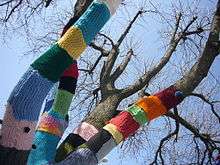
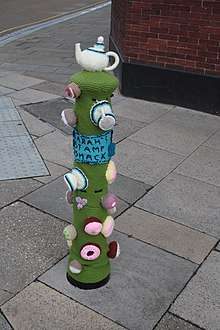
Motivation
While yarn installations – called yarn bombs or yarnstorms – may last for years, they are considered non-permanent, and, unlike other forms of graffiti, can be easily removed if necessary. Nonetheless, the practice is still technically illegal in some jurisdictions, though it is not often prosecuted vigorously.[1]
While other forms of graffiti may be expressive, decorative, territorial, socio-political commentary, advertising or vandalism, yarn bombing was initially almost exclusively about reclaiming and personalizing sterile or cold public places.[2] It has since developed with groups graffiti knitting and crocheting worldwide, each with their own agendas and public graffiti knitting projects being run.[3]
According to Manuela Farinosi and Leopoldina Fortunati, yarn bombing has become synonymous with the current feminist movement due in part to the reclamation of the traditionally feminine arts of knitting and/or crocheting to partake in the traditionally masculine and male-dominated graffiti scene.[4] The women and girls who make up the yarn bombing subculture are diverse in race, age, sexuality, class, etc., and create space for themselves and their art everywhere from college campuses to public parks. This creation and preservation of space is what motivates some of the participants, some of whom have never been able to access a political art space before. In her article about yarn bombing, Joanna Mann explains the balance between the art and politics, "Yarn bombing, I argue, does more than feminise the city, for the whimsy with which it is imbued has the capacity to increase our attentiveness to habitual worlds in a series of micro-political gestures."[5]
History

The practice is believed to have originated in the U.S. with Texas knitters trying to find a creative way to use their leftover and unfinished knitting projects, but it has since spread worldwide.[1][2][6]
The start of this movement has been attributed to Magda Sayeg, 37, from Houston, who says she first got the idea in 2005 when she covered the door handle of her boutique with a custom-made cozy.[7]
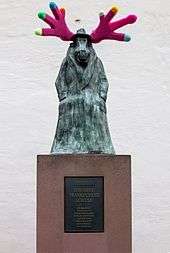
Houston artist Bill Davenport was creating and exhibiting crochet-covered objects in Houston in the 1990s, and the Houston Press stated that "Bill Davenport could be called the grand old man of Houston crocheted sculpture."[8] Artist Shanon Schollian was knitting stump cozies in 2002 for clear cuts in Oregon.[9] The Knit Knot Tree by the Jafagirls[10] in Yellow Springs, Ohio gained international attention in 2008.
The movement moved on from simple 'cozies' with the innovation of the 'stitched story'. The concept has been attributed to Lauren O'Farrell[11] (who creates her street art under the graffiti knitting name Deadly Knitshade), from London, UK, who founded the city's first graffiti knitting collective Knit the City. The 'stitched story concept' uses handmade amigurumi creatures, characters, and items to tell a narrative or show a theme. This was first recorded with the Knit the City collective's "Web of Woe" installation[12] in August 2009.
The Knit the City collective were also the first to use O'Farrell's term 'yarnstorming' to describe their graffiti knitting, as an alternative to the more popular term 'yarnbombing'.[13][14]
Yarn bombing's popularity has spread throughout the world. In Oklahoma City the Collected Thread store yarn bombed the Plaza District of the city on 9 September 2011 to celebrate their three-year anniversary as a functioning shop.[15] and in Australia a group called the Twilight Taggers refer to themselves as 'fibre artists'.[16] Joann Matvichuk of Lethbridge, Alberta founded International Yarnbombing Day, which was first observed on 11 June 2011.[17]
Although yarnbomb installations are typically found in urban areas, Stephen Duneier, aka Yarnbomber, was the first to introduce it into the wilderness with numerous permitted projects in Los Padres National Forest beginning in 2012.[18]
The Craft Club Yarnbombers (Emma Curley, Helen Thomas, Gabby Atkins, Claire Whitehead and Rebecca Burton) became Guinness World Record holders for the largest display of crochet sculptures, when they yarnbombed a children's hospice with 13,388 crocheted items.[19] They have also brought yarnbombing to their community in Essex with their postbox yarnbombs.[20]
Yarn Bombing Los Angeles (YBLA) is a yarn bombing collective located in Los Angeles, CA. The collective describe themselves as a group of guerrilla knitters who have been collaborating since 2010. They hold monthly meetings to develop plans for events, share techniques, develop their collective community, etc. They currently have 10+ projects in progress throughout the Los Angeles and nearby communities.[21]
Criticisms
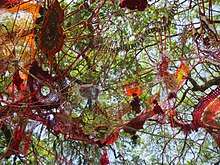
Yarn bombing has been under some scrutiny for the potential negative environmental impact that the yarn can have when placed on plant life. Yarn can restrict sap production on trees and constrict growth.[22] The knitted material requires removal and cleaning up; if left behind, installations become soggy and synthetic fibers litter the environment.[23]
The street artist Olek (Agata Oleksiak) has yarn bombed New York City icons such as the Wall Street bull and the Astor Place Cube.[24] She faced legal trouble after her unauthorized installation in an underwater museum allegedly damaged marine life, the very cause she was attempting to raise awareness for.[25] Olek also makes public statements with her work, such as blanketing a women's homeless shelter in Delhi in 2015[26] or installing an underwater cosy at the Cancun Underwater Museum.[25]
The Knit Your Revolt Tricycle Gang in Queensland protests "anti-bikie" laws that outlaw motorcycle gangs by demonstrating on yarnbombed tricycles.[27]
Advertising campaigns have capitalized on the yarnbombing trend: Knit the City was commissioned by Toyota to create a 2013 installation in London.[28] London Kaye creates yarnbomb graffiti and, in addition to her art installations, creates advertisement yarnbombs for brands like Valentino and Miller Lite.[29][24] Kaye has received backlash for her installations when they are hung in public unauthorized, and one installation in Bushwick called "Moonshine Kingdom" was met with arguments that spray graffiti is prosecuted as illicit, while white trendy yarn graffiti is not criminalized.[30] Public outcry concerning the installation labeled this type of graffiti a symbol of gentrification,[30] although an article by The New York Times claims a double standard in criticism of yarnbombing, and that women's work is seen as cutsie and inherently less valuable.[29]
Some people suggest that instead of wasting knitting to make art, people should make sweaters for the homeless.[23]
Literature
In September 2009 Yarn Bombing: The Art of Crochet and Knit Graffiti[31] by Leanne Prain and Mandy Moore was published by Arsenal Pulp Press in Canada, the US, and the UK. The book was translated into German in 2011. Now in its third printing, a second edition was published in Fall 2019.
In Europe Knit the City: Maschenhaft Seltsames[32] by Deadly Knitshade was published in February 2011 by Hoffmann und Campe in Germany. It was originally written in English, and was published by Summersdale in the UK in September 2011 as Knit the City: A Whodunnknit Set in London.[33][34]
YarnBombing Los Angeles released a self-published catalog of an exhibit held at 18th Street Arts Complex, Santa Monica, CA in June 2011 titled Yarn Bombing 18th Street[35] by Arzu Arda Kosar.
Gallery
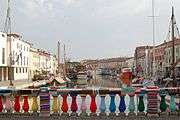 Yarn bombing on a bridge in Cesenatico (Italy).
Yarn bombing on a bridge in Cesenatico (Italy).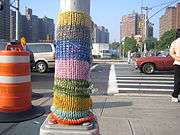 Yarn Bombing in New York City
Yarn Bombing in New York City- Yarn bombing, Alicante Spain.
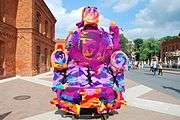 Yarn Bomb attached to a train
Yarn Bomb attached to a train- Yarn bombing specimen, Nederland, 2011
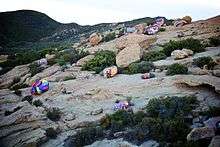 Lizards Mouth Yarnbomb Installation by Stephen Duneier (Spring 2014)
Lizards Mouth Yarnbomb Installation by Stephen Duneier (Spring 2014) Alien Campsite Yarnbomb Installation by Stephen Duneier (Feb 2015)
Alien Campsite Yarnbomb Installation by Stephen Duneier (Feb 2015)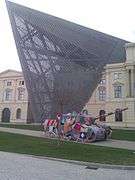 Knitted graffiti, on tank before the Military Museum in Dresden, Germany
Knitted graffiti, on tank before the Military Museum in Dresden, Germany "Knit the Bridge" yarn bombing event on the Andy Warhol Bridge in Pittsburgh
"Knit the Bridge" yarn bombing event on the Andy Warhol Bridge in Pittsburgh- Yarn bombing of the Jan Karski bench in New York City
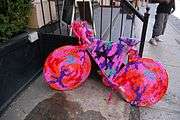 Yarn bombing of a bicycle in New York City
Yarn bombing of a bicycle in New York City Louis Bourgeois' Maman sculpture in Roppongi Hills, Tokyo, covered in yarn by textile artist Magda Sayeg to celebrate the 15th anniversary of Roppongi Hills.
Louis Bourgeois' Maman sculpture in Roppongi Hills, Tokyo, covered in yarn by textile artist Magda Sayeg to celebrate the 15th anniversary of Roppongi Hills.
References
- Wollan, Maria (18 May 2011). "Graffiti's Cozy, Feminine Side". The New York Times.
- Anonymous (21 January 2009). "Knitters turn to graffiti artists with 'yarnbombing'". The Telegraph. London. Retrieved 25 May 2009.
- McGovern, Alyce (6 March 2014). "Knit one, purl one: the mysteries of yarn bombing unravelled". The Conversation. Retrieved 6 March 2014.
- Farinosi, Manuela; Fortunati, Leopoldina (April 2018). "Knitting Feminist Politics: Exploring a Yarn-Bombing Performance in a Postdisaster City". Journal of Communication Inquiry. 42 (2): 138–165. doi:10.1177/0196859917753419.
- Mann, Joanna (March 2015). "Towards a politics of whimsy: yarn bombing the city". Area. 47 (1): 65–72. doi:10.1111/area.12164.
- Smee, Sebastian (25 December 2009). "Dave Cole takes knitting to new heights". Boston Globe. Retrieved 1 September 2010.
- The Wild and Woolly World of Yarn Bombing, Street Art's Soft Sensation BLOUINARTINFO.COM
- Art: The Third Dimension, Houston Press, 1 June 2000
- "nw drizzle monthly arts, music & culture e-zine". Nwdrizzle.com. 11 September 2001. Retrieved 9 May 2013.
- "Jafagirls: YARNBOMBING".
- "London's graffiti knitters". The Daily Telegraph. May 2012. Retrieved 5 May 2012.
- "London's Graffiti Knitters". Telegraph Travel. Retrieved 11 March 2012.
- Costa, Maddy (11 October 2010). "The Graffiti Knitting Epidemic". The Guardian. Retrieved 11 March 2012.
- Sillito, John (13 June 2009). "Knitting but not as we know it". BBC.
- "Collected Thread".
- "Twilight Taggers".
- Mollins, Julie (10 June 2011). "Graffiti knitters to hit streets on Yarnbombing Day". Reuters. Retrieved 13 June 2011.
- Cooper, Arnie (8 March 2015). "The Guerrilla Art of the Yarnbomb Goes Natural". Newsweek. Retrieved 10 December 2015.
- "Largest display of crochet sculptures". Guinness World Records.
- "Yarn bombers spread Essex commuter Christmas cheer". BBC News. 6 December 2014.
- "about". Yarnbombing Los Angeles. Retrieved 17 April 2018.
- Mann, Joanna (28 January 2017). "Knitting the archive: Shetland lace and ecologies of skilled practice". Cultural Geographies. 25: 91–106. doi:10.1177/1474474016688911.
- "'Yarn Bombing' Is The New Graffiti, But Is That OK?". The Odyssey Online. 22 March 2016. Retrieved 4 March 2019.
- Fry, Naomi (17 February 2020). "By Hook or by Crook: Woolly". The New Yorker: 30, 31.
- Thomas, Emily (20 August 2014). "Artist Olek's Underwater Crochet 'Bomb' May Have Killed Marine Life". HuffPost. Retrieved 4 March 2019.
- Harrington, Jaime Rojo & Steven (25 March 2015). "Gender, Caste, And Crochet: OLEK Transforms A Shelter in Delhi". HuffPost. Retrieved 4 March 2019.
- Stitch, The (8 December 2013). "Why I started a Knit Your Revolt Tricycle Gang in Queensland | The Stitch". The Guardian. ISSN 0261-3077. Retrieved 4 March 2019.
- Price, Laura (February 2015). "Knitting and the City: Knitting and the City". Geography Compass. 9 (2): 81–95. doi:10.1111/gec3.12181.
- Miller, Jennifer (2 December 2016). "Yarn Bombing Hits the High Street". The New York Times. ISSN 0362-4331. Retrieved 4 March 2019.
- Whitford, Emma (18 September 2015). "This Wes Andersony Crochet Graffiti Is Causing Extreme Bushwick Gentrification Anxiety". Gothamist.
- Moore, Mandy; Prain, Leanne (2009). Yarn Bombing: The Art of Crochet and Knit Graffiti. Arsenal Pulp Press. ISBN 978-1-55152-255-5.
- Knitshade, Deadly (2011). Knit the City: Maschenhaft Seltsames. Germany: Hoffman und Campe. ISBN 978-3-455-38105-4.
- Knitshade, Deadly (2011). Knit the City: A Whodunnknit Set in London. London: Summersdale. ISBN 978-1-84953-179-5.
- "Foto's van Rosa Sosa". Facebook. Retrieved 9 May 2013.
- Kosar, Arzu (2012). Yarn Bombing 18th Street. CreateSpace Independent Publishing Platform. ISBN 978-1-47002-190-0.
Further reading
| Wikimedia Commons has media related to Knitted graffiti. |
- Mandy Moore, Leanne Pain, Yarn Bombing, the Art of Crochet and Knit Graffiti, Arsenal Pulp Press, 2009
- Deadly Knitshade, Astrid Finke, Knit the City – Maschenhaft Seltsames, Hoffmann und Campe, Hamburg 2011, ISBN 978-3-455-38105-4.
- Langreiter, Nikola (2012), "Neues Handarbeiten – Radical? Revolutionary? Guerilla?", in Hannes Obermair; et al. (eds.), Regionale Zivilgesellschaft in Bewegung - Cittadini innanzi tutto, Vienna-Bolzano: Folio Verlag, pp. 183–204, ISBN 978-3-85256-618-4
- Lewis, Perri, Guide to Night: Mark Thomas joins the guerrilla knitters. The Guardian, 1 November 2009.
- Press Association, US town baffled by Midnight Knitter. Irish Independent, 11 March 2010.
- "Knitting but not as we know it", BBC News, Saturday 13 June 2009
- Costa, Maddy, "The graffiti knitting epidemic". The Guardian, 11 October 2010.
- 'Grandma Graffiti': German Knitting Guerillas Go Global, May 2011
- Knit Knot Tree, Do Trees Get Cold-offbeat knitting USA Today AP 11 March 2008
- foxtoledo.com Making Toledo a little more cozy: Yarn-Bombing phenomenon exploding in Toledo
- Milly, Jena (22 June 2011). "Yarn Bombing isn't Knit and Run Anymore". HuffPost. Retrieved 27 February 2012.
- Streetspun Yarnbombing, Warm and Fuzzy - Yarn bombers leave colorful mark on city ToledoBlade Online 22 APR 2012
- Urban Knitting, Un ponte di lana Romagna.com 10 March 2014
- Cooper, Arnie, Not Your Grandma's Crocheting ArtNews Magazine 18 Nov 2014
- Stewart, Ethan, Knitting Psychedelic Daydreams Santa Barbara Independent 11 Sept 2014
